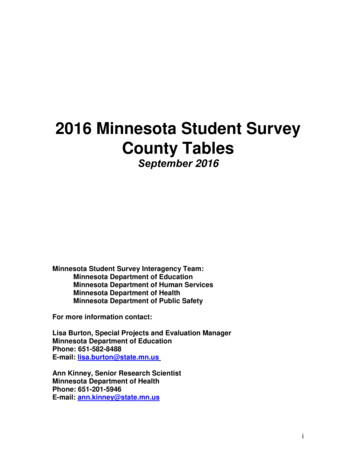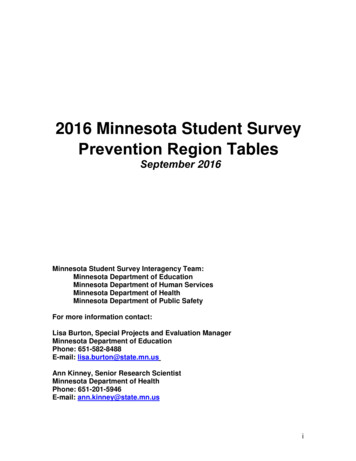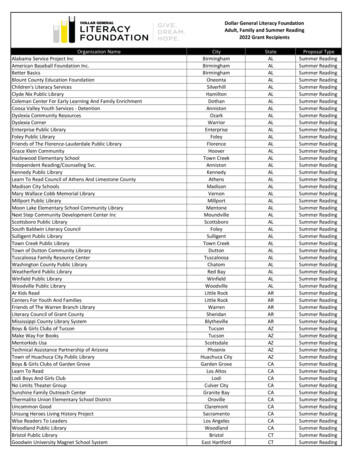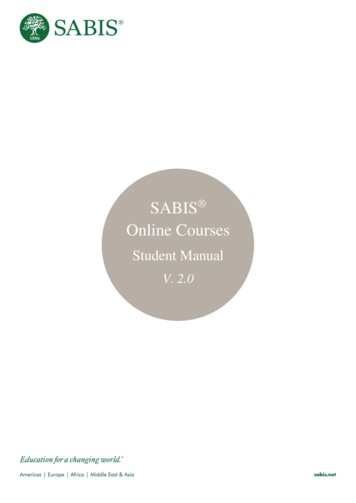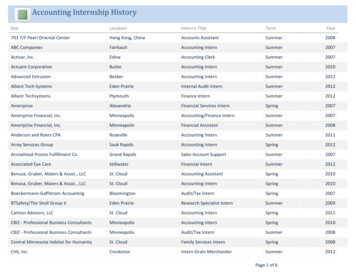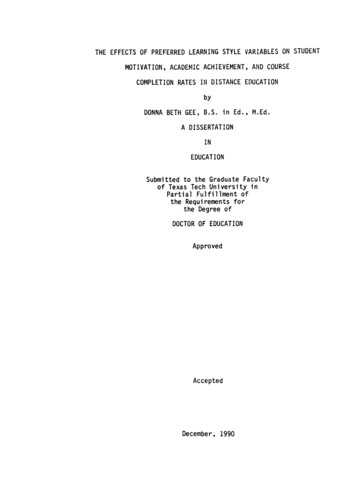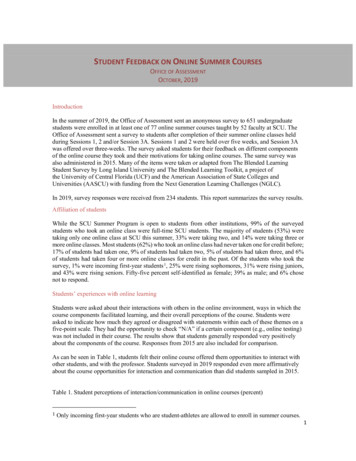
Transcription
STUDENT FEEDBACK ON ONLINE SUMMER COURSESOFFICE OF ASSESSMENTOCTOBER, 2019IntroductionIn the summer of 2019, the Office of Assessment sent an anonymous survey to 651 undergraduatestudents were enrolled in at least one of 77 online summer courses taught by 52 faculty at SCU. TheOffice of Assessment sent a survey to students after completion of their summer online classes heldduring Sessions 1, 2 and/or Session 3A. Sessions 1 and 2 were held over five weeks, and Session 3Awas offered over three-weeks. The survey asked students for their feedback on different componentsof the online course they took and their motivations for taking online courses. The same survey wasalso administered in 2015. Many of the items were taken or adapted from The Blended LearningStudent Survey by Long Island University and The Blended Learning Toolkit, a project ofthe University of Central Florida (UCF) and the American Association of State Colleges andUniversities (AASCU) with funding from the Next Generation Learning Challenges (NGLC).In 2019, survey responses were received from 234 students. This report summarizes the survey results.Affiliation of studentsWhile the SCU Summer Program is open to students from other institutions, 99% of the surveyedstudents who took an online class were full-time SCU students. The majority of students (53%) weretaking only one online class at SCU this summer, 33% were taking two, and 14% were taking three ormore online classes. Most students (62%) who took an online class had never taken one for credit before;17% of students had taken one, 9% of students had taken two, 5% of students had taken three, and 6%of students had taken four or more online classes for credit in the past. Of the students who took thesurvey, 1% were incoming first-year students 1, 25% were rising sophomores, 31% were rising juniors,and 43% were rising seniors. Fifty-five percent self-identified as female; 39% as male; and 6% chosenot to respond.Students’ experiences with online learningStudents were asked about their interactions with others in the online environment, ways in which thecourse components facilitated learning, and their overall perceptions of the course. Students wereasked to indicate how much they agreed or disagreed with statements within each of these themes on afive-point scale. They had the opportunity to check “N/A” if a certain component (e.g., online testing)was not included in their course. The results show that students generally responded very positivelyabout the components of the course. Responses from 2015 are also included for comparison.As can be seen in Table 1, students felt their online course offered them opportunities to interact withother students, and with the professor. Students surveyed in 2019 responded even more affirmativelyabout the course opportunities for interaction and communication than did students sampled in 2015.Table 1. Student perceptions of interaction/communication in online courses (percent)1Only incoming first-year students who are student-athletes are allowed to enroll in summer courses.1
greeNeitherDisagreenor AgreeAgreeStronglyAgreeI was able to share ideas with other students on aregular basis201511%14%40%35%20197%8%40%46%Sharing and discussion in the online environmentworked well20159%9%44%38%20198%9%35%49%The course offered ample opportunities forinteraction and communication from student tostudent20159%15%47%29%20199%10%43%38%The course offered ample opportunities forinteraction and communication from student toinstructor20156%18%39%37%20198%10%33%49%The course offered ample opportunities forinteraction and communication from instructor 9%30%201915%8%32%44%The technology used in this class allowed me toparticipate at least as fully as I would have donein a classroom-only classStudents were also generally positive about the ways in which the structure of the course facilitatedlearning. Students in 2019 also responded more positively about their learning than did studentssurveyed in 2015.Table 2. Student perceptions of learning in online courses reenor AgreeAgreeStronglyAgreeI clearly understood the components andstructure of the course20156%9%48%37%20197%8%35%50%Online learning modules helped me understandthe course material20157%11%45%37%20198%8%37%48%Online testing was a good way to evaluate myunderstanding of the material201512%26%40%22%201912%10%39%38%Watching recorded lectures helped myunderstanding of the material in this rningOnline assignments or activities were helpful inunderstanding the course contentThe online components of this course workedwell to promote learning2
Students report high levels of satisfaction with their online course; as noted above, students in 2019 reporthigher levels of satisfaction compared with their peers in 2015.Table 3. Student satisfaction with online courses (percent)General sagreenor AgreeAgreeStronglyAgreeI would take another online course at SCU in 9%35%20%16%201937%32%16%15%I would recommend taking online courses to afriendOverall, I am satisfied with this online courseThe time I spent online would have been betterspent in a face-to-face classStudents were also asked about how helpful certain elements of their online course were for theirlearning. Their responses reinforce the importance of developing quality online learning componentsand students’ ability to work at their own pace in the online experience. (See Tables 4-6.)Table 4. Student perceptions of helpfulness of elements related to interaction/communication (percent)Interaction/CommunicationYearNot at allhelpful/ Moderately Very e interaction with students (e.g.,discussion board, chats, e-mails)201522%30%29%19%201915%30%24%31%Online interaction with faculty (e.g.,discussion board, chats, e-mails)201516%22%33%29%201910%23%28%39%3
Table 5. Student perceptions of helpfulness of elements related to learning (percent)LearningYearNot at allhelpful/ Moderately Very e material (e.g., demonstrations, videosand simulations, links to relevant websites)20158%18%37%37%20196%18%27%49%Ability to review online presentations 22%32%27%201912%19%37%32%Online examinationsTable 6. Student perceptions of helpfulness of elements related to flexibility (percent)FlexibilityAbility to work at my own paceFlexibility of being able to completeassignments any place/ any timeYearNot at allhelpful/ Moderately Very %61%When teaching online, it can be especially important to schedule in opportunities for students toprovide feedback on the course materials. Students were asked whether they had such opportunities togive the instructor feedback. Twenty percent said that they were not given that opportunity, 44% saidthat they had one or two opportunities to give feedback, and 37% said they were given a number ofopportunities to give feedback.Preferences for online/hybrid formatsIt is interesting to learn more about students’ preferences for online/hybrid courses versus face-to-facecourses. Students were asked first which class format they preferred for courses taken during thesummer. As the figure below indicates most prefer entirely online or a predominantly online coursewith some face-to-face contact. The percentage of students who preferred entirely online courses wasgreater (by 11%) than in 2015. In future iterations of the survey, it would be helpful to know if thestudents who prefer some face-to-face contact are within driving distance of SCU during the summerand are available to come to campus.4
Preference for class format in 6% 16%9% 4%3% 3%Entirely online Extensive web, Equal mix Mostly face-to- Entirely facesome face-to- online & face- face, minimalto-facefaceto-facewebStudents responded differently when asked about which class format they preferred for courses takenduring the regular school year, showing a much stronger preference for entirely or predominantlyface-to-face courses.Preference for class format in regular school year40%35%33% 34%30%25%27%20%36%28%21%15%201910%5%0%20153% 4%7% 7%Entirely online Extensive web, Equal mix Mostly face-to- Entirely facesome face-to- online & face- face, minimalto-facefaceto-facewebStudents were also asked about their interest in taking a class during the regular academic year thatblended online learning with face-to-face instruction (meeting, for example one day a week face-toface and the other day online). Forty-three percent of students said they would be very interested inthis, 30% said that they would be somewhat interested, 20% were not very interested or not interestedat all, and 7% stated that they were unsure.In Their Own Words: Student responses to open-ended questionsOpen-ended questions were included in the survey providing students the opportunity to expand upontheir experiences. Student responses to the open-ended questions were examined and the results arepresented in the following sections.5
Why students take online coursesOne of the open-ended questions asked students why they chose to take an online class. Over half(52%) of the students stated that a key reason was to fulfill a requirement either for their major or theuniversity core. A number of students (31%) took an online class because it offered more flexibility inthe summer or during the school year. The professor or the class material itself was of specific interestto 6% of students. The opportunity to graduate early were important factors for 4% of studentssurveyed. Another 4% used the online classes as a means of having something to do during thesummer. Additional reasons for taking an online class included strengthening transfer applications andpreparing for future exams.What was especially effective?The students were also asked what was particularly effective in the online class. Of the students whoresponded, 18% of the student responses praised the professors for their clear communication with theclass. Specifically, 15% of responses appreciated the feedback between professor and student, withone student commenting that their professor “was extremely available and listened to feedbackregarding course materials.” Another remarked, “Communication was encouraged so much that italmost felt like an in-class experience which I really enjoyed.” Many others mentioned the “teacher’sfeedback,” “teaching style,” and the “interaction with the professor.”In addition, 23% of comments noted that the lectures, tests/quizzes, and other class materials providedby the professor were valuable, and 10% of comments addressed the organization of the class andwebsite. One student noted, “The organization was key. The modules were really well organized andplanned out, and each assignment and its respective due date were always abundantly clear, whichmade for time management to be easy!” And for one student, “The professor showed us some greatonline resources (particularly videos) that were extremely helpful in helping us understand thematerial.”The flexibility of online courses and the opportunity for students to work at their own pace andschedule was mentioned in 21% of comments. One student noted, “The flexibility it allowed – I couldwork when I wanted to and get ahead to a certain degree, I could complete the work from anywhere, Icould also review lectures/videos several times to make sure I understood the material.” Othersappreciated how online classes were “very easy to manage while working and being occupied withother life tasks.”The discussion and communication among peers were also important (receiving 18% of mentions).One student commented, “I thought the discussion was useful because it required everyone to interactwith one another virtually which, in my opinion, eliminates the aspect of students being reserved inthe classroom.” Another pointed to the benefits of peer-to-peer learning through discussion, “I likedhow you could always go back and read classmates responses, which allowed me to see differentviews on a matter and help me to go back and look at the evidence that goes along with the newviews.” Many viewed discussion forums as an easy way to communicate and appreciated discussionboards for review and preparation for assignments.What was less effective?Although communication was praised in many student comments, it also emerged in responses to thequestion of what was less effective in their online course. In fact, the most common response waslimited communication with both the professor and other classmates, with 28% of commentsmentioning this as a weakness in the online class. One student pointed out that “It’s difficult becauseeveryone is doing assignments at different times so leaving comments is difficult and even harder torespond to those.” Another commented, “The lack of face-to-face instruction and reminders6
sometimes led to misunderstanding or missed assignments.” And another student wrote, “Discussionsdid not feel like ideas were being argued/modeled.” Furthermore, 8% of students mentioned thechallenges of coordinating a group project online. One student commented, “Group projects were verydifficult due to time zone changes and schedules.”In addition, there were a number of comments (9%) about the course organization and the difficulty innavigating and getting material for the course. For example, one noted, “It was tough to grasp theorganizational structure. There was a lot going on in the modules and there were a lot of due dates tokeep track of.” And several others noted the confusion they had regarding the format of the class andthe professor’s expectations, “The fact that it was entirely online made it difficult at times tounderstand what I had to do and what exactly the teacher’s expectations for each assignment were.”Finally, 23% of comments addressed lectures, quizzes/tests or other class materials provided by theprofessor. One student commented, “Some video lectures were not as necessary as others or spent animbalanced amount of time covering additional information rather than on the most difficult topics.”Or, “Online testing felt very restrictive and I don’t know how much I absorbed by watching recordingof class lectures.” A small number of student comments asked for more lectures and or shorterreadings.Would students have preferred to take their course as a face-to-face course?Students were also asked if they would have preferred to take their class in a face-to-face setting,rather than online. The majority of students (67%) stated that they preferred the online format. Ofthese students, 25% mentioned that this was particularly true in the summer because of the flexibilityoffered by online classes. Another 6% mentioned how they learned a lot through this online format.However, there were many students 27% who responded that they would have preferred taking it as aface-to-face class. Of these, 13% felt they would have had better communication among themselves,their classmates, and their professor. A few students (10%) mentioned they prefer a face-to-face class,but were okay with and appreciated the convenience of the online format. One student noted, “I wouldhave liked some face to face time with instructor. However, the online format fits easily into a hecticschedule and still provides a rich learning experience.” Finally, 6% of students said it didn’t matter tothem whether the course was online or face-to-face.ConclusionOf the students who responded to the survey, most reported being very satisfied with their experiencesin their online courses. Additionally, the survey results affirm that summer courses fill a valuable rolein affording many students more flexibility and opportunity in achieving their goals towardcompleting their academic programs and the Core curriculum, and providing them with moreopportunities to explore additional courses.The faculty member’s work and preparation involved in transforming a face-to-face course into aneffective online course is clearly an essential piece of the students’ positive experiences. Studentsexpressed appreciation for a well-organized course that allowed them to find course materials easilyand know what to anticipate in readings, assignments, exams, and participation throughout the fiveweek course time frame. Opportunities for timely communication with faculty are especiallyimportant to clarify questions about assignments or readings, and for students to receive feedback ontheir work. Students also appreciate learning with and from peers through discussion forums andopportunities for peer feedback, although in some classes, this was less successfully implemented.This area, as well as the effectiveness of some of the online lectures and testing, seem to be the biggestareas for SCU to target development and improvement opportunities.7
Student comments help us see that the faculty member plays an instrumental role in creating anenvironment that helps establish a sense of community and engaged learning, even in an onlineenvironment. For over a dozen years, mandatory training has been in place to help faculty prepare toteach their first online course at the SCU. The training program was redesigned and brought in-housein 2015 when the University created a new position to support faculty teaching online – theOnline/Blended Learning Specialist. Approximately 60% of the 2019 summer online facultycompleted the University’s in-house Course Redesign Seminar. Additionally, to better support facultycontinuing to teach in the summer online program, Online Course Refresh workshops were developedby Academic Technology to share best practices and provide faculty more tools to improvecommunity, student engagement, and foster a culture of continuous improvement. These 2018 and2019 workshops have been completed by 32% of the summer 2019 faculty. As SCU considers ways tofurther support faculty who have redesigned courses for online or hybrid teaching, AcademicTechnology and the Collaborative for Teaching Innovation continue to build on current efforts tosupport a community of faculty teaching online, e.g., quarterly lunches to facilitate peer support, newworkshops, and faculty CAFEs or Forums. Such opportunities offer facSumulty valuable ideas abouthow to manage the communication flow between themselves and students, how to design and managediscussion boards to elicit engaging discussions, and how to construct online course elements,including the overall course design and online lectures. Efforts are ongoing to facilitate further facultynetworks or groups.Acknowledgements: The Office of Assessment is grateful for the assistance of Kyla Inouye, StudentAssistant, for her work in preparing this report.8
students were enrolled in at least one of 77 online summer courses taught by 52 faculty at SCU. The Office of Assessment sent a survey to students after completion of their summer online classes held during Sessions 1, 2 and/or Session 3A. Sessions 1 and 2 were held over five weeks, and Session 3A was offered over three-weeks.
